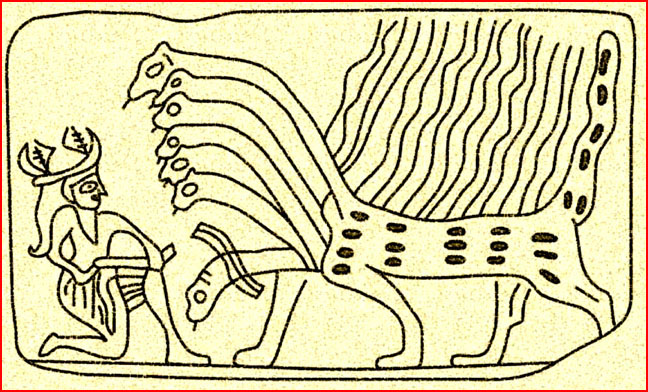|
[For background on
this discussion, see the url's listed below.]
To uncover the
secret of the thunder-weapon in world mythology we must
trace the theme back to its early expressions in ancient
Mesopotamia. When the Babylonians, the world's first
astronomers, looked back to the age of the gods, they
spoke incessantly of disaster. In their Akitu festival,
a prototype of ancient New Year's celebrations, the
astronomer priests recounted the events of a former
time, when the dragon Tiamat assaulted the world and it
appeared that heaven itself would fall into chaos. (See
the above image of the seven-headed dragon, Tiamat,
taken from a Babylonian cylinder seal.) The "resplendent
dragon" spawned a horde of dark powers with
"irresistible weapons"--"monster serpents,
sharp-toothed, with fang unsparing", their bodies filled
with poison for blood. "Fierce dragons she has draped
with terror, crowned with flame and made like gods", the
storytellers recounted, "so that whoever looks upon them
shall perish with fear". This was not a disaster on a
local scale, but a universal disaster--a catastrophe so
great that the gods themselves were immobilized by fear,
and even Anu, the sovereign of the sky, fled the scene
in terror.
The protagonist in
this narrative is the god Marduk. When all else had
failed, it was Marduk who rose to confront Tiamat and
her companions. The god took possession of his
"matchless weapons" and--
"In front of him he set the lightning,
With a blazing flame he filled his body"
Mounted on his
storm-chariot and turbaned with a "fearsome halo,"
Marduk set his course toward the raging Tiamat. In the
encounter that followed,
"Tiamat opened her mouth to consume him,
He drove in the Evil Wind that she close not her
lips.
As the fierce winds charged her belly,
Her body was distended and her mouth was wide open.
He released the arrow, it tore her belly,
It cut through her insides, splitting the heart".
Cuneiform
specialists confirm that the arrow of Marduk was the
thunderbolt, a weapon frequently displayed throughout
the ancient Near East and beyond. We have already noted
that the Sumerian warrior Ninurta defeated the monster
Anzu with his thunderbolt, just as the Greek Zeus
subdued Typhon with the thunderbolt. But the early
traditions of earthshaking battles in the heavens were
not limited to any particular culture. At the temple of
Ra in Heliopolis the priests ritually trod underfoot
images of the great dragon Apep to represent his defeat
at the hands of the supreme god. At the temple of Edfu,
a series of reliefs depict the warrior Horus and his
followers vanquishing Apep or his counterpart Set,
cutting to pieces the monster's companions, the "fiends
of darkness". According to W. M. Muller, the spear or
harpoon of Horus was a metaphor for the thunderbolt.
"Lightning is the spear of Horus, and thunder the voice
of his wounded antagonist, roaring in his pain", Muller
reports.
The Hebrews, too,
preserved an enduring memory of Yahweh's battle against
a dragon of the deep, marked by lightning on a cosmic
scale. "The voice of thy thunder was in the heaven: the
lightnings lightened the world: the earth trembled and
shook". Here the adversary was alternately named Rahab,
Leviathan, Tannin, or Behemoth--dragon-like forms
representing both the waters of chaos and the rebellion
of the "evil land" vanquished by Yahweh in primeval
times.
The battle is
echoed in Job 26: "The pillars of heaven shook and were
astounded at his roar. By his power he stilled the sea,
and by his understanding he smote Rahab". It is also
well established that the Hebrew accounts reflect a
connection to early Canaanite traditions in which the
thunderbolt-wielding god Baal defeated the monster Lotan.
Comparison of the
cross-cultural traditions suggests a human memory
reaching far beyond any tribal or regional influence.
Yet similarities abound, and unexplained similarities
are the key to discovery. What ancient event provoked
the human memory of a dragon attacking the world? Who
was the warrior-god who confronted the monster? And what
was the invincible "thunderbolt" that defeated the
beast? The questions can be answered if we allow the
ancient witnesses to speak--and to mean what they say.
See also:
Mystery of the Cosmic Thunderbolt(1)
Mystery of the Cosmic Thunderbolt(2)
Mystery of the Cosmic Thunderbolt(3) |

